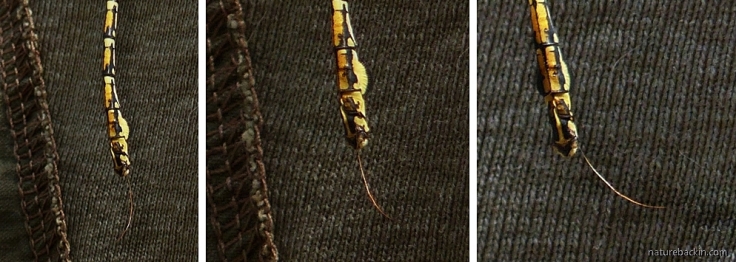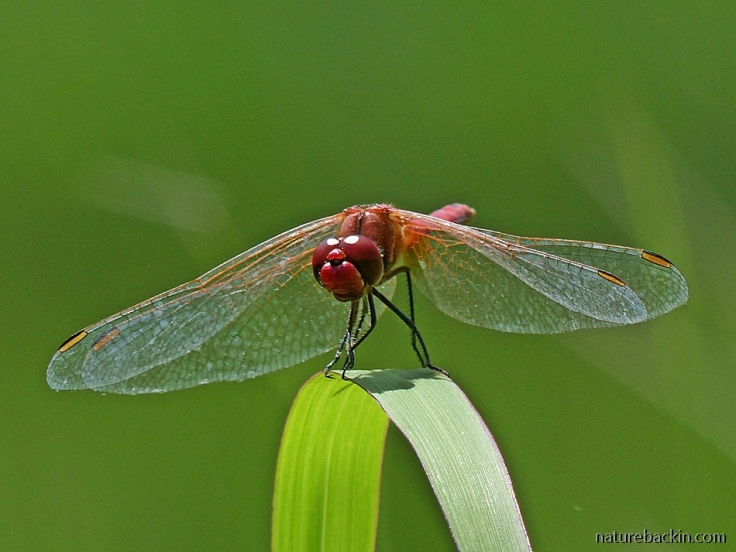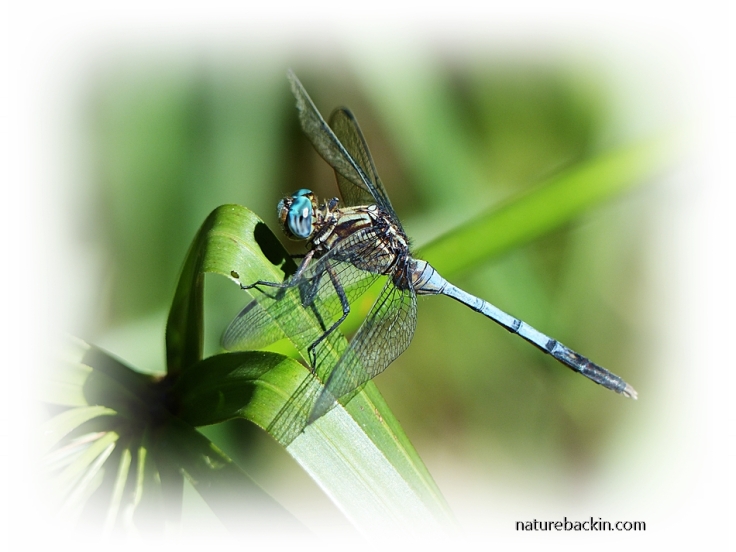Considering there are over 3000 species of dragonflies in the world, it’s not surprising that a few find their way to our garden pond.
The beauty of dragonflies, with the fine filigree of their transparent and sometimes iridescent wings and their often electric colours, has inspired artists and jewellery designers across time and space.

There is something about dragonflies that captures the imagination
The flying abilities of dragonflies have also inspired aircraft designers. Dragonflies can use each of their four wings independently, and in addition to being able to fly and manoeuvre with incredible speed, they can fly backwards as well as hover in one spot.

A dragonfly at rest, showing off its amazing flying apparatus
Dragonflies are carnivorous insects and with their speed and excellent eyesight they are effective hunters. They hunt while flying, able to home in on their quarry and catch it with their feet. They have powerful toothed mandibles. They belong to the order Odonata, which means the” toothed ones”.

The multifaceted compound eyes of dragonflies provide them with excellent eyesight and their strong veined wings are very maneuverable. They hunt in flight, grabbing prey with their legs before subduing or killing it with a bite

Usually I see dragonflies perched with their wings outspread similar to the wings of an aeroplane, but this one often perched while tipping forward with its wings lifted in between frequent hunting forays
Obviously, we are most familiar with adult dragonflies as we can see them in flight, but the longest period of a dragonfly’s life is in larval form. Dragonfly larvae are aquatic and they have gills so that they can breathe underwater. Like the adults, the larvae are carnivorous and hunt underwater. Prey includes worms, insect larvae, including mosquito larvae, and also tadpoles. They go through several stages or instars, moulting their exoskeleton at each stage. When they reach adulthood they climb out of the water for their final moult when their wings are fully developed.

This dragonfly, perching on the leaf of a water plant at our garden pond, shows how its large eyes form much its head

One day after I hung out the washing, I noticed this dragonfly attracted to the damp fabric of a T-shirt. I am not very good at identifying dragonflies, but I know for sure that this is a Common Thorntail (Cretogomphus pictus) male
There is a bit of a story attached to this Common Thorntail, which is not so common that I see them often in our garden, by the way. Because it is such a striking dragonfly that I had not seen before I took some photos of it. I then noticed something very peculiar. It appeared to have a long filament tail that moved independently, this way and that – almost as if it were licking the damp fabric. I was incredulous and I called my husband to come and see it, and we could not figure it out.

This photo of the Common Thorntail show the long filament tail-like thread at the end of its abdomen

In these photos, the filament “tail” can be seen. Now and again it moved, curling slightly from side to side
I was so mystified that I sent some photos in an email to an entomology professor who had published a book on South African dragonflies. He was the one who identified the dragonfly as a Common Thorntail, correcting my incorrect endeavour, which is why I have not tried to identify any of the other dragonflies in the photos in this post! It is rather strange that the name should involve the tail, as the mysterious tail-like filament was the subject of my question.
Anyway, regarding the “tail” the entomologist said that he thought it was the antenna of a prey item that had got stuck to the top of a segment of the abdomen. It is anatomically impossible for it to be part of the dragonfly, which I knew, but what mystified me was that it was moving – and there was no breeze or wind on that day. So, I can only assume that the detached antenna of an insect can carry on moving, as this one did as we watched for a period of several minutes until the dragonfly decided to fly away.
All the photos above were taken in our garden, but the photos below (except for the last one) were taken in someone else’s garden near a small dam in the KwaZulu-Natal Midlands.

A lovely scarlet dragonfly perching on the leaf of a reed on the edge of the dam
The presence of dragonflies indicates that the water that sustains them is of good quality. Dragonflies do not survive in polluted or acidic water. The website “Odes for Beginners” has interesting information on dragonfly conservation including on threats to their survival and tips on their preservation. For garden ponds to support dragonflies and their larvae, submerged aquatic plants are needed as well as vegetation on the margins of the pond, providing shelter and of course perches. It is preferable to use indigenous plants and definitely not invasive alien plants that can clog up our waterways.

Suitable perches are essential for hardworking hunters!

The tip of this perch is well worn. This photo was taken in autumn this year, with autumn leaves providing the background colour

The same dragonfly on the same perch, lit by the afternoon sun, but in this photo deep shadow darkens to black behind it
At our garden pond, I have seen only individual dragonflies visiting. I am not aware of any breeding pairs or any egg-laying taking place, but perhaps that happens without me noticing. Now that we no longer have fish in our garden pond, the conditions will be more favourable for any dragonfly larvae that might hatch there.

Sources:
Introduction to the Odonata. Dragonflies and Damselflies. http://www.ucmp.berkeley.edu/arthropoda/uniramia/odonatoida.html; Odes for Beginners http://www.odesforbeginners.com/default.aspx
Posted by Carol









November 23, 2018 at 1:38 pm
Fantastic images, well caught!
LikeLiked by 1 person
October 20, 2018 at 4:30 am
Ah dragonflies. I’m envious of you seeing so many that are willing to perch. The ones I see always seem to be on the wing and even though they will fly back and forth over the same area, I find it very difficult to get decent photos of them. This is a great set of photos and information. They’re such strange looking creatures up close, but so much fun to watch.
LikeLike
October 19, 2018 at 7:02 pm
Wonderful macro shots of these beautiful jewels. We don’t seem to have any at our new location (no pond), but I used to see quite a few when I had the goldfish pond at the previous abode. They are so fascinating with their glittering florescence. You captured them well.
LikeLiked by 1 person
October 22, 2018 at 6:57 pm
Thanks Gunta. Yes they are like jewels.
LikeLike
October 19, 2018 at 3:25 pm
Such a wonderful gallery of dragons…I seldom get them to sit still for my lens – thank you for posting!
LikeLiked by 1 person
October 20, 2018 at 7:43 am
Thanks very much Leya. I have that problem with butterflies!
LikeLiked by 1 person
October 20, 2018 at 1:05 pm
Agree…
LikeLike
October 19, 2018 at 8:53 am
Astonishing gallery.
LikeLiked by 1 person
October 20, 2018 at 5:26 am
Luckily they pose most cooperatively! Thank you Tish.
LikeLiked by 1 person
October 19, 2018 at 8:49 am
Fabulous!
Never seen a Thorntail.
We get three or four species here on a regular basis.
The only one that looks vaguely familiar is the blue one. Is it perhaps a Blue Emperor?
LikeLiked by 1 person
October 20, 2018 at 7:42 am
Thanks Ark. Re the blue one, I was thinking a Julia Skimmer?
LikeLiked by 1 person
October 20, 2018 at 11:11 am
Probably. You are more clued up than I am.
LikeLiked by 1 person
October 22, 2018 at 7:16 pm
I don’t think so!
LikeLiked by 1 person
October 19, 2018 at 8:15 am
Once again, loved you pics as well as the useful information, Carol
LikeLiked by 1 person
October 20, 2018 at 5:18 am
Thanks so much Suzette. I expect that dragonflies visit your ponds too?
LikeLike
October 19, 2018 at 7:26 am
These are exceptional photo to accompany your post. I’m particularly interested that dragonflies only prosper where the water quality is good. This is cheering news as they are abundant round here.
LikeLiked by 2 people
October 19, 2018 at 8:04 am
I found that interesting too! They swarm our pond. My son and I catch many dragonfly larvae in our net, when fishing for minnows. We have raised a few, and they are indeed voracious predators!
LikeLiked by 2 people
October 20, 2018 at 5:17 am
How nice that they benefit from your pond. I have read about dragonflies swarming but have not seen that here.
LikeLike
October 20, 2018 at 5:15 am
Thanks Margaret. Their association with clean water is interesting, and so it is extra good that they prosper in your area.
LikeLike
October 19, 2018 at 5:47 am
Stunning pictures and very interesting informations about these beautiful insects!
LikeLiked by 1 person
October 20, 2018 at 4:43 am
Thanks Simone. They are beautiful little creatures.
LikeLiked by 1 person
October 19, 2018 at 3:55 am
Very interesting!
LikeLiked by 1 person
October 19, 2018 at 7:48 pm
Thanks Anne. I tried to make this a shorter post, but it turned out longer than I planned. They are interesting little creatures.
LikeLike
October 19, 2018 at 1:51 am
Terrific macro shots, Carol, and really any guide book would be so much the better for including these shots of yours!
LikeLiked by 2 people
October 19, 2018 at 7:39 pm
Thank you for your generous comment. Dragonflies helpfully return to the same perch again and again, which assists any photographer!
LikeLiked by 1 person
October 19, 2018 at 12:45 am
Beautiful series of photographs!
LikeLiked by 1 person
October 19, 2018 at 7:36 pm
Thanks Belinda. I know that you also enjoy photographing dragonflies.
LikeLiked by 1 person
October 19, 2018 at 10:02 pm
Yes I do. Sadly the season has come to an end here.
LikeLiked by 1 person
October 19, 2018 at 12:26 am
Dragonflies are so beautiful. You have done them justice, here.
LikeLiked by 1 person
October 19, 2018 at 7:35 pm
Thanks for your kind comment Sandy.
LikeLiked by 1 person
October 19, 2018 at 7:37 pm
Certainly.
LikeLiked by 1 person
October 19, 2018 at 12:02 am
You have many beautifully marked species there. I found the Common Thorntail esp. lovely and fascinating. I wondered if perhaps you saw a horsehair worm emerging? Not sure if there are species in your area, but they live in freshwater and are parasites of various insects. While dragonflies weren’t listed as hosts, supposedly a worm can survive its host being preyed upon and emerges intact. Just a thought!
LikeLiked by 1 person
October 19, 2018 at 7:33 pm
Thanks for your thoughtful comment Eliza. The entomologist considered the possibility of it being an emerging parasite, but in one of the photos I sent him, but not posted on the blog, it does appear that the filament is stuck on the outside on the top of the abdomen. Also when enlarging the photos, the filament is segmented and gradually tapers down, as an antenna does. Pity I could not get better quality pics – I was using the zoom lens so as not to frighten the dragonfly off. I agree it is a particularly striking dragonfly – even without its mystery appendage 🙂
LikeLiked by 1 person